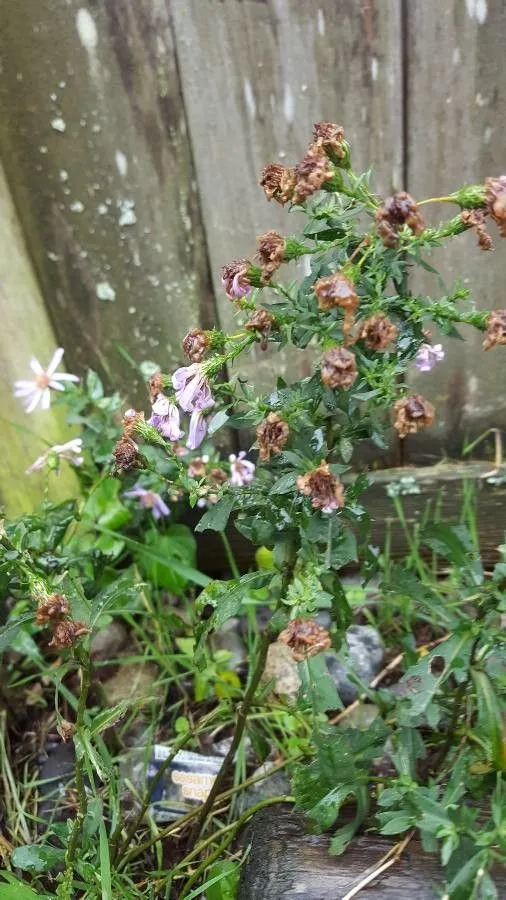
Author: (L.) Cass.
Bibliography: Dict. Sci. Nat., ed. 2. 37: 487 (1825)
Year: 1825
Status: accepted
Rank: species
Genus: Eurybia
Vegetable: False
Observations: Canada to U.S.A.
The Bigleaf aster, scientifically known as Eurybia macrophylla, is a hardy and adaptable plant native to a wide range extending from Canada to the United States. This resilient species falls under the Asteraceae family, which is renowned for its diverse and colorful members.
Originally chronicled in the early 19th century, with its formal description appearing in the second edition of the “Dict. Sci. Nat.” (1825), Eurybia macrophylla was documented by the botanist L. Cass. This robust herbaceous perennial is easily recognized by its expansive, broad leaves from which it derives its common name. The leaves are not only large, but also heart-shaped with a rough texture that can often reach substantial sizes, adding to the plant’s distinctive appearance.
Bigleaf asters typically thrive in woodland settings, ideally flourishing in partial to full shade. They are well-adapted to the understory of forests, where they can effortlessly colonize shady and moist areas. The flowering season of Eurybia macrophylla adds to its botanical charm, gracing the late summer and early autumn landscapes with delicate, star-shaped flowers. The blooms usually present a pale violet to blue hue, although they can sometimes sport white petals, a feature that makes them visually appealing in naturalized gardens and wildflower meadows.
Ecologically, the Bigleaf aster plays an essential role in its native habitats. It attracts a variety of pollinators, including bees and butterflies, thus contributing to the health and sustainability of local ecosystems. Its robust foliage provides shelter and food for various insects and small animals, underscoring its importance beyond mere ornamental value.
Gardeners and botanists alike appreciate the Bigleaf aster for its hardiness and minimal maintenance requirements. Its ability to propagate through rhizomes allows it to form dense groundcover, making it an excellent choice for erosion control on slopes and in forested areas. While it prefers well-drained soil rich in organic matter, it can tolerate a range of soil types, thus showcasing its adaptability.
In summary, Eurybia macrophylla, or the Bigleaf aster, is a notable member of the Asteraceae family, valued for its large, striking foliage and charming late-season flowers. Its widespread distribution from Canada to the United States highlights its adaptability and ecological significance within North American flora. Whether observed in its natural habitat or cultivated in a garden, this plant continues to be a symbol of resilient beauty and ecological utility.
Eng: bigleaf aster, large-leaved aster, big-leaved aster, large-leaved wood aster
Deu: großblättrige aster, großblättrige waldaster
Dan: storbladet asters
Nld: grote aster
Fra: aster à grandes feuilles, aster à grande feuille, pétouane
Swe: glandelaster, prärieaster
En: Bigleaf aster, Large-leaved aster, Big-leaved aster, Large-leaved wood aster
Da: Storbladet asters
Nl: Grote aster
Fr: Aster à grandes feuilles, Aster à grande feuille, Pétouane
De: Großblättrige Aster, Großblättrige Waldaster
Sv: Glandelaster, Prärieaster
Taken Sep 25, 2020 by 123_itsme (cc-by-sa)
Taken Sep 17, 2021 by Martin Nobert (cc-by-sa)
Taken Aug 5, 2021 by Makayla Osipenko (cc-by-sa)
Taken Nov 17, 2021 by Alessandro Braidotti (cc-by-sa)
Taken Aug 29, 2020 by Charles Small (cc-by-sa)
Taken Oct 18, 2019 by Zack Simon (cc-by-sa)
Taken Jul 2, 2021 by Ripley Maddock (cc-by-sa)
Taken Oct 10, 2018 by Lisa J (cc-by-sa)
Taken May 6, 2022 by William Coville (cc-by-sa)
Taken Oct 9, 2021 by Peter Francissen (cc-by-sa)
Taken Aug 29, 2022 by Greg Tank (cc-by-sa)
Taken Sep 19, 2019 by Conrad Beauvais (cc-by-sa)
Taken Nov 6, 2022 by Pascal Berthet (cc-by-sa)
Taken Oct 25, 2022 by William Coville (cc-by-sa)
Taken Sep 23, 2020 by Carter Pleau (cc-by-sa)
Taken Jun 23, 2022 by B K (cc-by-sa)
Taken Jul 26, 2022 by Tristan Jaton-Maria (cc-by-sa)
Taken Jul 2, 2021 by Ripley Maddock (cc-by-sa)
Taken Jun 9, 2020 by Josh M (cc-by-sa)
Taken Jun 24, 2022 by PT (cc-by-sa)
Taken Jul 30, 2018 by tmzante@gmail.com (cc-by-sa)
Taken Sep 29, 2019 by Caleb Bowser (cc-by-sa)
Taken Feb 18, 2008 by EOL − Chicago Botanic Garden 2007 (cc-by-nc-sa)
Growth form: Rhizomatous
Growth habit: Forb/herb
Growth rate: Moderate
Ph maximum: 6.9
Ph minimum: 4.9
Family: Myrtaceae Author: (F.Muell.) K.D.Hill & L.A.S.Johnson Bibliography: Telopea 6: 402 (1995) Year: 1995 Status:…
Family: Rubiaceae Author: Pierre ex A.Froehner Bibliography: Notizbl. Bot. Gart. Berlin-Dahlem 1: 237 (1897) Year:…
Family: Sapindaceae Author: Koidz. Bibliography: J. Coll. Sci. Imp. Univ. Tokyo 32(1): 38 (1911) Year:…
Family: Asteraceae Author: A.Gray Bibliography: Pacif. Railr. Rep.: 107 (1857) Year: 1857 Status: accepted Rank:…
Family: Fabaceae Author: Medik. Bibliography: Vorles. Churpfälz. Phys.-Ökon. Ges. 2: 398 (1787) Year: 1787 Status:…
Family: Aspleniaceae Author: (Cav.) Alston Bibliography: Bull. Misc. Inform. Kew 1932: 309 (1932) Year: 1932…